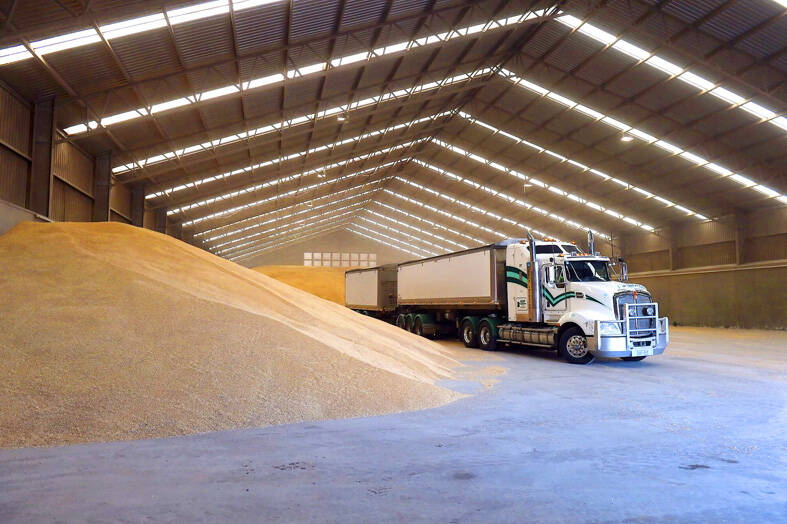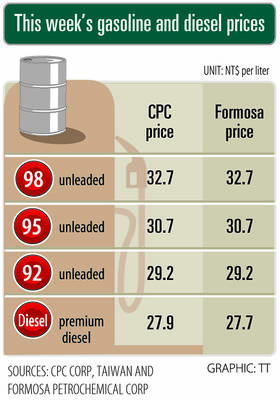Three years after steep Chinese tariffs halted imports of Australian barley as tensions between the two countries ratcheted higher, the grain once again is flowing freely.
Barley is not only used to brew beer, but to feed pigs, and China was Australia’s leading market, taking 50 percent of its barley exports. China has imported 314,000 tonnes of Australian barley worth A$139 million (US$94.7 million) since the government scrapped its 80.5 percent tariffs in August, the Australian government said early this month, citing official Chinese data.
The resumption of trade is a welcome relief for Australian farmers, who saw a nearly A$1 billion market evaporate in 2020.

Photo: Bloomberg
“In the two months following the market’s reopening, [CBH] Marketing and Trading shipped two vessels of barley to China,” the CBH Group, a cooperative of more than 3,500 Western Australian grain farmers, said in its annual report.
Tensions between the countries began to mount in 2018 when Australia excluded Chinese telecommunications giant Huawei Technologies Co (華為) from its 5G network. Then in 2020, Australia called for an international investigation into the origins of COVID-19 — an action China saw as politically motivated as it came from a close partner of the US.
In response, Beijing slapped high tariffs on key Australian exports, including barley, beef and wine, while halting its coal imports.
A slowdown in China’s economic growth has spurred Beijing to rekindle its relationships with its trading partners.
Meanwhile, Australia sought out and found new markets to offload its harvests — it is the world’s third-largest producer of the grassy grain.
“It caused us to pivot, so we found new markets, like Mexico. We managed to have tariffs lowered, which were previously in excess of 100 percent,” said Sean Cole, acting general manager of the GrainGrowers trade association.
“With China gone, Australia was really forced to go back to more traditional customers in the feed market, mainly the Middle East and Saudi Arabia, where we’ve been for over 20 years,” he said. Between June last year and June this year, Saudi Arabia became the leading importer of Australian barley, data from the Australian Bureau of Agricultural and Resource Economics and Sciences (ABARES) showed.
Lyndon Mickel farms a 6,000 hectare plot near Beaumont in the southwest part of Australia. His most recent harvest fields of grains and peas was the 23rd of his career, but it has taken time to bounce back from the Chinese tariffs.
“We’ve had a reduction in price, but we’ve been fortunate we’ve had two very good years in that time crop-wise, so what we’ve lost in price, we’ve gained in tonnage anyway,” he said.
However, those boom years — producing more than 14 million tonnes of barley in the past two harvests — are over.
As El Nino — the cyclical weather phenomenon responsible for higher global temperatures — returns to the Pacific, ABARES expects barley production to drop 24 percent to 10.8 million tonnes for the 2023-2024 harvest.
The reopening of the Chinese market could not have come at a better time, Cole said.
“A lot of our barley is classified as feed, but it is still suitable for beer manufacturing in China,” he said. “They use slightly different processes, and essentially it means we can get a premium for more of our feed barley.”
On average, barley destined for China is sold for “around 38 to 40 dollars a tonne between now and since the tariffs were lifted” and that amounts to “an extra 400 million dollars value for the Australia barley crop next year, even with a smaller crop,” Cole added.

Hon Hai Precision Industry Co (鴻海精密) yesterday said that its research institute has launched its first advanced artificial intelligence (AI) large language model (LLM) using traditional Chinese, with technology assistance from Nvidia Corp. Hon Hai, also known as Foxconn Technology Group (富士康科技集團), said the LLM, FoxBrain, is expected to improve its data analysis capabilities for smart manufacturing, and electric vehicle and smart city development. An LLM is a type of AI trained on vast amounts of text data and uses deep learning techniques, particularly neural networks, to process and generate language. They are essential for building and improving AI-powered servers. Nvidia provided assistance

GREAT SUCCESS: Republican Senator Todd Young expressed surprise at Trump’s comments and said he expects the administration to keep the program running US lawmakers who helped secure billions of dollars in subsidies for domestic semiconductor manufacturing rejected US President Donald Trump’s call to revoke the 2022 CHIPS and Science Act, signaling that any repeal effort in the US Congress would fall short. US Senate Minority Leader Chuck Schumer, who negotiated the law, on Wednesday said that Trump’s demand would fail, while a top Republican proponent, US Senator Todd Young, expressed surprise at the president’s comments and said he expects the administration to keep the program running. The CHIPS Act is “essential for America leading the world in tech, leading the world in AI [artificial

DOMESTIC SUPPLY: The probe comes as Donald Trump has called for the repeal of the US$52.7 billion CHIPS and Science Act, which the US Congress passed in 2022 The Office of the US Trade Representative is to hold a hearing tomorrow into older Chinese-made “legacy” semiconductors that could heap more US tariffs on chips from China that power everyday goods from cars to washing machines to telecoms equipment. The probe, which began during former US president Joe Biden’s tenure in December last year, aims to protect US and other semiconductor producers from China’s massive state-driven buildup of domestic chip supply. A 50 percent US tariff on Chinese semiconductors began on Jan. 1. Legacy chips use older manufacturing processes introduced more than a decade ago and are often far simpler than

Gasoline and diesel prices this week are to decrease NT$0.5 and NT$1 per liter respectively as international crude prices continued to fall last week, CPC Corp, Taiwan (CPC, 台灣中油) and Formosa Petrochemical Corp (台塑石化) said yesterday. Effective today, gasoline prices at CPC and Formosa stations are to decrease to NT$29.2, NT$30.7 and NT$32.7 per liter for 92, 95 and 98-octane unleaded gasoline respectively, while premium diesel is to cost NT$27.9 per liter at CPC stations and NT$27.7 at Formosa pumps, the companies said in separate statements. Global crude oil prices dropped last week after the eight OPEC+ members said they would